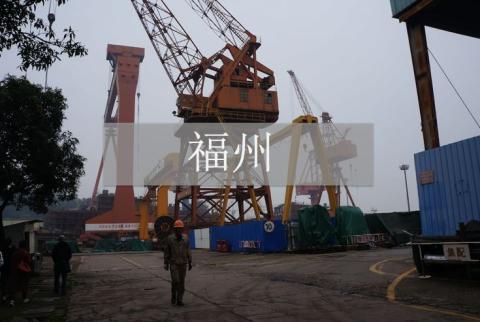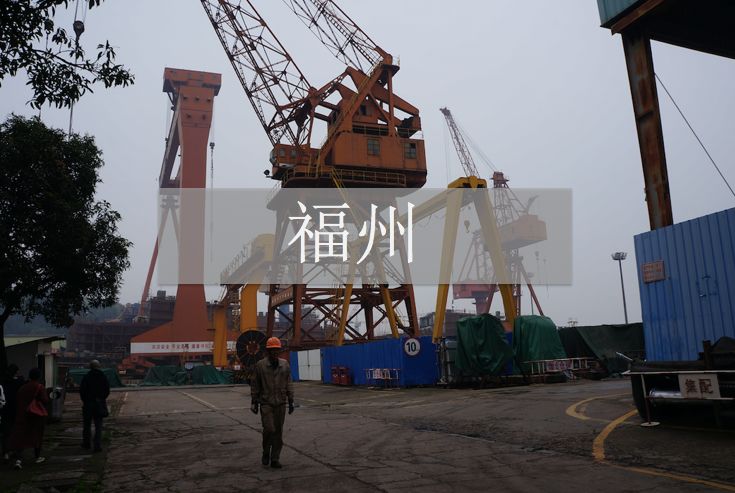

Perhaps, they are nostalgic for a certain way of life. Probably, only socialist countries have such a way of life.
After leaving Fuzhou Station, our friends Liang Feng and Dong Qi picked us up and went straight to Mawei Shipyard.
Mawei Shipyard is also the location of the famous Mawei Shipbuilding Bureau in modern times. Zuo Zongtang, Shen Baozhen, Yan Fu, Lin Zexu, Li Hongzhang, Liu Buchan, Deng Shichang...19A group of famous officials and generals performed here at the end of the century The dramatic drama of their lives. Perhaps at that time, Fuzhou was as prosperous as Shanghai because of Mawei Shipbuilding, a military-industrial center and the site of the "Westernization Movement." But the current situation has changed, and Fuzhou, today, may have a faint sigh of fate.



At the factory gate, Liang Feng’s sister, an employee of the shipyard, took us in. China's factory entrances and uniform buildings from the 1950s and 1960s, which once represented the scale, systematization, and pride of the working class, now look shabby and low. Liang Feng, who was born in the late 1970s, said he often came here to play when he was a child. At that time, he thought there were so many people here and the factories were so big. I haven’t been here for a long time, but now that I see you again, this feeling seems to have escaped.
Arriving at a red brick building, this seemingly inconspicuous French-style building is the oldest mechanical workshop in China - the turbine factory where the shipyard produced marine steam engines. Sister Liang found an interpreter to come over and introduced: "The first marine steam engine manufactured by us Chinese was built in this shipbuilding turbine factory. It was 1871 ”
The turbine factory workshop is very unique and was designed by the French. The commentator said that the French built two such factories, one in France and the other right here. The one in France has long since disappeared, and only two-thirds of the one in Mawei remain. The other one-third was destroyed by Japanese planes during the Anti-Japanese War. The wooden frame on the top of the workshop is said to be rosewood purchased from Southeast Asia and is quite strong. The cast iron pillars and the tracks used by some cranes at that time are still preserved. Now this workshop has been listed as a national key cultural relic protection unit.
The second floor of this red building was the Shipbuilding and Painting Institute of the year. The space here is spacious and the windows are high and bright, making it an ideal place for drawing design and drawing. More than a hundred years ago, ship design drawings were drawn here, and it was also here that China's first generation of ship technology talents were born.
Now, the Shipbuilding and Painting Institute has become the Mawei Shipyard History Exhibition Hall. Hundreds of pictures and a large number of precious cultural relics condense the rise and fall of the Mawei Shipyard over more than 100 years. Here, the commentator also told us about two black events in the history of Mawei Shipbuilding - the "Majiang Naval Battle" and the "Sino-Japanese War of 1894". Especially the latter. Our history textbooks specifically mention these two heroic figures Liu Mingchan and Deng Shichang. When I was in school, I just memorized them by rote. But when I saw the detailed information and objects here, I was born to understand this tragedy. The tragic coming of the battle.
I don't know who said something at that time: "Fujian people are really cruel. If you can't beat them, they will die together. Unlike the Northeastern people who just yell."
Regarding the once-popular TV series "Young Marshal", many people said that this TV series not only beautified Zhang Xueliang, but also made the historical fact that 300,000 Northeastern troops fled to North China without resistance justifiable. However, the ferocity of the Fujian people still remains. Liang Feng said that in his hometown in Lianjiang, there are still fights between villages over a water source every year.


After viewing the factory history exhibition hall, I stood on the iron terrace on the second floor of the Red Building and looked out. The factory is surrounded by mountains and rivers and is huge in scale. There is a Mazu temple on the mountain. It is said that it existed as early as the Shipping Administration Bureau of the late Qing Dynasty. There are several shipyards along the river, and the river is foggy, making it difficult to see and understand the huge industrial structures.
It was noon when we came out of the Red Building. Suddenly, many people in work clothes appeared on the factory road. They rushed towards the factory entrance and dispersed like a tide.
Dong Qi said that when she was a child, she lived in a steel factory with her parents in Hefei, which was also a heavy industrial zone. Everything in life, including education, medical care, and entertainment, could be satisfied in this large factory community. Dong Qi said that she missed the collective life in the compound and it felt very simple.


I am no stranger to such a scene, but I am an outsider. When I was a child, my family was in a village sandwiched between a large living area where locomotives were manufactured and repaired. Although we do not belong to their worker system, they help us with the road in front of our home, the tap water system at home, satellite TV, telephone communications, etc. You can even go to school, see a doctor, go to the movies, canteen, and party. We children often sneak into the park inside their factory to play. Every day at meal time, we watched the workers carrying lunch boxes and riding motorcycles and bicycles flock to the canteen; every evening, their children walked past our door in small groups carrying a basket of bath supplies to go to their public bathhouse. Taking a bath... But now, this scene has faded. I heard that the business of this factory is gradually being integrated into the Liuzhou Railway Headquarters. Many changes have also taken place in my hometown. Many paths, streams, and ponds have disappeared. The once abandoned gardens have been replaced by commercial housing. Many of the memories of our generation’s growth are nowhere to be found.
When I was writing this article, news about the former Soviet Union's "Chernobyl Nuclear Disaster 30" popped up on the Internet. At the end of the article, it was said that "some old people miss their homeland and return home despite the ban." .
Perhaps, they are nostalgic for a certain way of life. Probably, only socialist countries have such a way of life.

